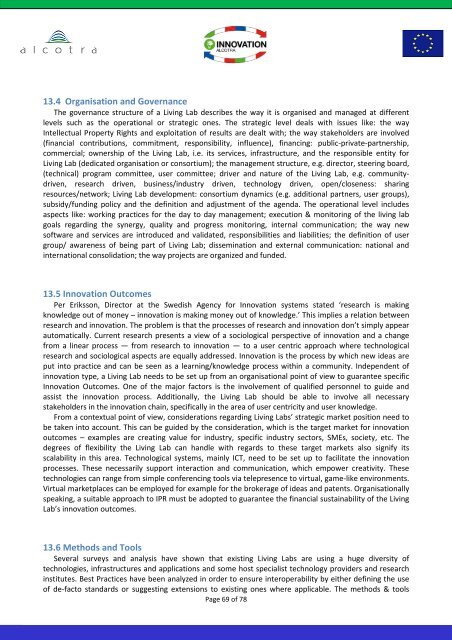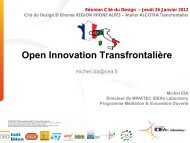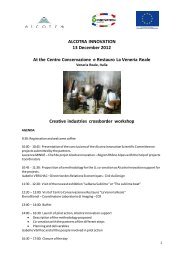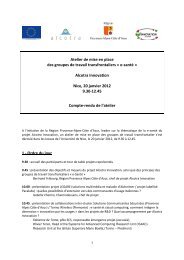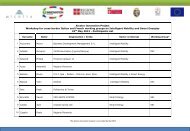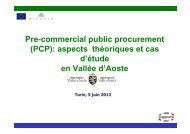Best practices Database for Living Labs - ALCOTRA - Innovation
Best practices Database for Living Labs - ALCOTRA - Innovation
Best practices Database for Living Labs - ALCOTRA - Innovation
You also want an ePaper? Increase the reach of your titles
YUMPU automatically turns print PDFs into web optimized ePapers that Google loves.
13.4 Organisation and Governance<br />
The governance structure of a <strong>Living</strong> Lab describes the way it is organised and managed at different<br />
levels such as the operational or strategic ones. The strategic level deals with issues like: the way<br />
Intellectual Property Rights and exploitation of results are dealt with; the way stakeholders are involved<br />
(financial contributions, commitment, responsibility, influence), financing: public-private-partnership,<br />
commercial; ownership of the <strong>Living</strong> Lab, i.e. its services, infrastructure, and the responsible entity <strong>for</strong><br />
<strong>Living</strong> Lab (dedicated organisation or consortium); the management structure, e.g. director, steering board,<br />
(technical) program committee, user committee; driver and nature of the <strong>Living</strong> Lab, e.g. communitydriven,<br />
research driven, business/industry driven, technology driven, open/closeness: sharing<br />
resources/network; <strong>Living</strong> Lab development: consortium dynamics (e.g. additional partners, user groups),<br />
subsidy/funding policy and the definition and adjustment of the agenda. The operational level includes<br />
aspects like: working <strong>practices</strong> <strong>for</strong> the day to day management; execution & monitoring of the living lab<br />
goals regarding the synergy, quality and progress monitoring, internal communication; the way new<br />
software and services are introduced and validated, responsibilities and liabilities; the definition of user<br />
group/ awareness of being part of <strong>Living</strong> Lab; dissemination and external communication: national and<br />
international consolidation; the way projects are organized and funded.<br />
13.5 <strong>Innovation</strong> Outcomes<br />
Per Eriksson, Director at the Swedish Agency <strong>for</strong> <strong>Innovation</strong> systems stated ‘research is making<br />
knowledge out of money – innovation is making money out of knowledge.’ This implies a relation between<br />
research and innovation. The problem is that the processes of research and innovation don’t simply appear<br />
automatically. Current research presents a view of a sociological perspective of innovation and a change<br />
from a linear process — from research to innovation — to a user centric approach where technological<br />
research and sociological aspects are equally addressed. <strong>Innovation</strong> is the process by which new ideas are<br />
put into practice and can be seen as a learning/knowledge process within a community. Independent of<br />
innovation type, a <strong>Living</strong> Lab needs to be set up from an organisational point of view to guarantee specific<br />
<strong>Innovation</strong> Outcomes. One of the major factors is the involvement of qualified personnel to guide and<br />
assist the innovation process. Additionally, the <strong>Living</strong> Lab should be able to involve all necessary<br />
stakeholders in the innovation chain, specifically in the area of user centricity and user knowledge.<br />
From a contextual point of view, considerations regarding <strong>Living</strong> <strong>Labs</strong>’ strategic market position need to<br />
be taken into account. This can be guided by the consideration, which is the target market <strong>for</strong> innovation<br />
outcomes – examples are creating value <strong>for</strong> industry, specific industry sectors, SMEs, society, etc. The<br />
degrees of flexibility the <strong>Living</strong> Lab can handle with regards to these target markets also signify its<br />
scalability in this area. Technological systems, mainly ICT, need to be set up to facilitate the innovation<br />
processes. These necessarily support interaction and communication, which empower creativity. These<br />
technologies can range from simple conferencing tools via telepresence to virtual, game-like environments.<br />
Virtual marketplaces can be employed <strong>for</strong> example <strong>for</strong> the brokerage of ideas and patents. Organisationally<br />
speaking, a suitable approach to IPR must be adopted to guarantee the financial sustainability of the <strong>Living</strong><br />
Lab’s innovation outcomes.<br />
13.6 Methods and Tools<br />
Several surveys and analysis have shown that existing <strong>Living</strong> <strong>Labs</strong> are using a huge diversity of<br />
technologies, infrastructures and applications and some host specialist technology providers and research<br />
institutes. <strong>Best</strong> Practices have been analyzed in order to ensure interoperability by either defining the use<br />
of de-facto standards or suggesting extensions to existing ones where applicable. The methods & tools<br />
Page 69 of 78<br />
The project is co-funded by the ERDF


